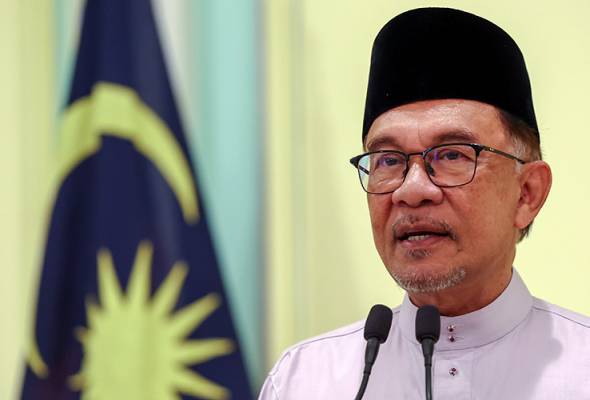
Published by AsiaNewsToday & AstroAwani, image by AsiaNewsToday.
Yang Amat Berhormat Dato’ Seri Anwar Ibrahim’s ascent to power not only marks the first time the country has a leader from a multi-ethnic party (not just coalition) becoming the Prime Minister (PM) but who’s also an Islamist.
Anwar’s detractors either tend to (deliberately) “forget” or be “dismissive” of this, i.e., his Islamist credentials.
However, Anwar hasn’t taken to flaunting/cosplaying his Islamist identity and virtue-signalling vis-à-vis his political adversaries (i.e., those outside of the national unity government). In keeping with his reputation as man of the people, the PM has instead focused on his immediate priorities which are tackling the cost of living.
The cost of living has indeed been a core and central feature of EMIR Research’s policy concerns pre-dating GE15, even all the way back to 2019 (i.e., before the Tanjung Piai by-election in November) based on the concept of the perut or tummy economy and as confirmed and vindicated by our quarterly polls.
Indeed, during his first press conference, the PM had already declared that he will convene the National Action Council on the Cost of Living (Naccol) to discuss the matter. At the meeting on November 27 (Sunday), he gave Naccol two weeks to analyse and assess/evaluate subsidy implications in order to come up with a targeted approach (“Anwar gives Naccol two weeks to analyse subsidy implications”, The Sun Daily, November 27, 2022).
A targeted subsidy approach would mean better focus in helping the targeted groups – thus enhancing the realisation of outcomes (O) and impacts (I).
As a staunch proponent of the IOOI model (Input, Output, Impact, Outcome), EMIR Research has also consistently call for ensuring that the allocations (input) are not only spent (output) but that the spending achieve their desired goals such as reducing reliance on unconditional cash transfers/UCTs (outcomes) and, thereby, providing the financial space for recipient households to progress towards a higher level of self-sufficiency, e.g., in the form of transition from low-income wage earner to a micro-entrepreneur (impact).
Targeted subsidies also mean more efficient and effective use of taxpayers’ money which is in line with the PM’s other priority – as can be seen in his declared intent to cut down the size of the Cabinet as well as reducing unnecessary (operational) expenditure (opex) for internal usage (e.g., official vehicles like the Mercedes S600 and the concomitant of fuel and maintenance expenses, office furniture, etc.) in what would be deemed as “efficiency savings” (in another parlance).
The savings from “subsidy rationalisation” can be then diverted to other welfare programmes.
One of which is the Assistive Basic Income (ABI) which lies at the heart of Barisan Nasional (BN)’s manifesto on the cost of living.
Whilst not exactly a Universal Basic Income (UBI) which is normally understood as being a permanent feature and structural, ABI (as also a targeted scheme) can nonetheless serve as an unconditional cash transfer (UCT) that will wipe out hardcore or absolute poverty.
ABI as intended for those earning below the current poverty line income (PLI) of RM2,208 – where cash will be credited every month – will overcome the policy constraints of the current UCT scheme (i.e., Bantuan Keluarga Malaysia/BKM) which is limited to periodic payments.
In this sense, the BKM can then be re-conceptualised to serve as a complement and supplement to ABI.
ABI will have the added impact of mitigating the loss of purchasing power among the lower-income group and provide financial breathing space to households.
EMIR Research would also like to propose the following:
- Dual-interest rate regime:
With the fourth consecutive Overnight Policy Rate (OPR) hike to 2.75%, this would mean the rise in the cost of loans affecting both businesses and households and, by extension, the cost of living.
The transmission mechanism for the channelling of interest rate hikes can be seen in the short-term, i.e., in terms of not only market rates but also market sentiments.
As per market rates, banks are earning higher profits due to the successive OPR hikes (“OPR hikes to boost bank’s earnings”, New Straits Times, November 7, 2022).
As per market sentiments, banks have been the top gainers/performers on Bursa (any differences in terms of losses had been extremely minimal) which is transmitted from higher interest income.
On the debt instrument front, banks are also top gainers from higher coupon rates for fresh issuance of government bonds as well as higher yields on the secondary markets.
According to Hong Leong Investment Bank Bhd analyst Chan Jit Hoong, “… banks were still short-term net beneficiaries as [the net interest margin or NIM] was anticipated to widen”. The NIM is simply the difference between the income earned from loans and the interest paid out for deposits.
He added that that “… every 25bps [in the] OPR hike would expand [the] NIM by 5.0-6.0bps which in turn, bump up earnings forecast by 4.0-5.0 per cent on a full-year basis, without taking into account … potential market-to-market losses and higher defaults”.
The government can certainly impose a windfall tax on the banks later as part of “recouping”, so to speak, of its expenditure to increase the targeted subsidy allocations.
This would partly relieve some pressure on our reliance on Petronas dividends for example – with oil prices expected to come down.
All the while as higher interest rates impact on the cost of doing business and cost of living, it’s recognised that the time lag for the supposed monetary policy to take effect would only be in the medium to long-term.
This can be vividly seen in Bank Negara’s more recent concern that core inflation has reached 4% (year-on-year/y-o-y), implying the need to pursue the trajectory of OPR hikes until inflation is tamed/dampened (see, “BNM may front-load more OPR hikes in 2023 to tackle core inflation, say economists”, The Edge Markets, November 4, 2022).
By which time then, Malaysia could well be in a downturn due to the impact from the global dynamics of concurrent rate hikes (e.g., see “Risk of Global Recession in 2023 Rises Amid Simultaneous Rate Hikes”, World Bank, September 15, 2022).
Be that as it may, banks can certainly afford a dual-interest rate regime which can be readily implemented. It’s just a matter of political will on all sides – regulator and lender (as mentioned in “Tackling inflation while helping the B40 – a dual track system”, BFM, August 10, 2022).
Bank Negara should instruct the commercial banks under the Central Bank Act (2009) to provide a lower interest rate (based on the OPR of 1.75% before the first hike in May 2022) to the B40 and M40 households.
Recall that the OPR is flanked by two sides of the corridor, namely the ceiling and floor rates which are separated from the OPR by 0.25% (25 bps/basis points). With 2.75% OPR, this means that the floor rate is at 2.50%. Even at 2.50% interest paid on deposits of commercial banks (at the Standing Facility/SF), they can still afford to allow the B40 and some M40 to pay their instalments based on pre-May interest rate.
The thing is for Bank Negara to ensure that more funds can be deposited by commercial banks – dubbed the Interbank Institutions under Klibor (Kuala Lumpur Interbank Offered Rate) system – by increasing its purchases of Malaysian Government Securities (MGS) from the commercial banks up to a certain level that ensures the target OPR level is hit. This requires some policy adjustments (limited type of quantitative easing or QE) but no need for legislative amendments to the 2009 Act as this isn’t at all debt monetisation.
So, with more money to lend out to each other, commercial banks will then have surpluses to be deposited with the SF to earn interest – which in turn will “cushion” or “buffer” the impact (on paper) of the dual-interest rate regime.
Otherwise, Bank Negara – again without any need to amend the 2009 Act – can require a lower SRR or statutory reserve requirement. After all, MGS and other government securities can now be used in lieu of cash deposits. The cash reserves can be diverted from the SR Accounts and deposited in the SF to earn interest.
Bank Negara can also provide a “special/concessionary” floor rate for participating banks at 2.75%.
As a dual-regime, it’ll not be “inflationary” – addressing those with weakened purchasing power (e.g., stagnant wages or wage cuts in real or effective terms).
Besides, as mentioned in EMIR Research article, “The domino effect of the OPR hike” (The Malaysian Reserve, May 30, 2022), increasing the interest rate which is inflationary (albeit not intended as such) will only increase demand for loans as people need to hold on to liquid assets (cash) to compensate for less savings (see, “Loan growth up to 5.0% pct in 2022 despite rising interest rates, says RAM Ratings”, Bernama, June 8, 2022).
Hence, a dual-regime addresses the supply-side issue as well.
2. Dual-Track Subsidy System:
Our subsidy system should be re-conceptualised and re-envisioned as revolving around our food security goals (short-, medium-, and long-term).
This means that whether it’s petrol or cooking oil subsidies for households and input subsidies for farmers and breeders, the subsidy system needs to be re-designed to support food security policies (rather than be regarded, as is customary, as simply welfare handouts).
For example, an immediate priority is for the PM and the government to de-centralise the padi supply chain by rechannelling the farmers directly to supermarkets/hypermarkets and other businesses (local and multinational companies or MNCs) as “integrators”.
The integrators provide basic inputs like fertilisers and seeds to the farmers together with the processing/milling plants. In turn, the farmers via farming cooperatives agree to sell unprocessed padi grains to the integrator at mutually agreed prices.
A tripartite collaboration can be formed with the government via the Malaysian Agricultural Research and Development Institute (Mardi), etc. for higher yield and quality paddy. Proprietary rights could be equally shared among the three.
The subsidy would then be re-diverted towards what would be a form of contract farming that improves the efficiency of the rice supply chain and increase farmers’ income and profit (see, e.g., “Empowering rural economy on road to self-sufficiency”, Malaysiakini, June 2, 2022).
In conclusion, the PM is expected to unrelentingly focus on the urgent policy issue of the cost of living as he also braces to grapple with other challenges on the other fronts – domestic (including the evil of ethno-religious incitements on social media, especially on TikTok) and international.
Dr Rais Hussin & Jason Loh Seong Wei are part of the research team of EMIR Research, an independent think tank focused on strategic policy recommendations based on rigorous research

